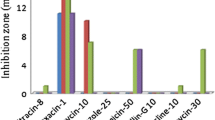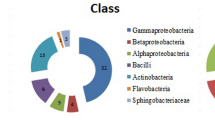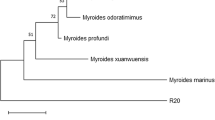Abstract
Plant growth-promoting (PGP) bacteria commonly have many strategies to cope with heavy metal toxicity. Heavy metal-resistant PGP bacteria can be used to improve the growth of plants in heavy metal contaminated soils. In this study, the soil samples were collected from the lead–zinc mineral deposits in Gümüşhane Province, Turkey. Nine bacterial isolates were obtained on the nutrient agar medium supplemented with 100 mg/mL zinc and lead. All of the isolates were screened in terms of plant growth-promoting characteristics including production of indole-3-acetic acid and siderophore, nitrogen fixation and phosphate solubilisation. Nine bacteria were identified as Bacillus cereus, Bacillus atrophaeus, Bacillus pumilus, Bacillus amyloliquefaciens, Bacillus tropicus, Bacillus subtilis, Bacillus halotolerans, Bacillus vallismortis, and Enterococcus mundtii by classical and 16S rDNA-PCR assays. In addition, these isolates were evaluated for their response to three heavy metals (lead, zinc, copper) dominant in the soil samples and minimal inhibitory concentration (MIC) of the heavy metals was determined with plate dilution method. Consequently, the bacterial isolates in this study possess plant growth-promoting traits and can ameliorate heavy metal contaminated soil. E. mundtii was reported to be found in heavy metal contaminated soil for the first time. This study is the first report about PGP characteristics (IAA production and phosphate solubilisation) of B. vallismortis.

Similar content being viewed by others
References
Ince M, Ince OK (2017) An overview of adsorption technique for heavy metal removal from water/wastewater: a critical review. Int J Pure Appl Sci 3(2):10–19. https://doi.org/10.29132/ijpas.358199
Viktorova J, Jandova Z, Madlenakova M, Prouzova P, Bartunek V, Vrchotova B, Lovecka P, Musilova L, Macek T (2016) Native phytoremediation potential of Urtica dioica for removal of PCBs and heavy metals can be improved by genetic manipulations using constitutive CaMV 35S promoter. PLoS ONE. https://doi.org/10.1371/journal.pone.0167927
Ertan B, Efe D (2019) The adsorption performance of urtica dioica on the removal of cadmium from aqueous solutions. Asian J Biot and Genet Eng 2(4):1–7
Srivastava N, Majumder C (2008) Novel biofiltration methods for the treatment of heavy metals from industrial wastewater. J Hazard Mater 151(1):1–8. https://doi.org/10.1016/j.jhazmat.2007.09.101
Silva L, Carvalho MA, de Souza SA, Dias PMT, Silva Filho RGd, Saramago CS, Bento CA, Hofer E (2012) Heavy metal tolerance (Cr, Ag and Hg) in bacteria isolated from sewage. Braz J Microbiol 43(4):1620–1631. https://doi.org/10.1590/S1517-83822012000400047
Baisak R, Rana D, Acharya PB, Kar M (1994) Alterations in the activities of active oxygen scavenging enzymes of wheat leaves subjected to water stress. Plant Cell Physiol 35(3):489–495. https://doi.org/10.1093/oxfordjournals.pcp.a078620
Ma Y, Rajkumar M, Luo Y, Freitas H (2013) Phytoextraction of heavy metal polluted soils using Sedum plumbizincicola inoculated with metal mobilizing Phyllobacterium myrsinacearum RC6b. Chemosphere 93(7):1386–1392. https://doi.org/10.1016/j.chemosphere.2013.06.077
Xie Y, Fan J, Zhu W, Amombo E, Lou Y, Chen L, Fu J (2016) Effect of heavy metals pollution on soil microbial diversity and bermudagrass genetic variation. Front Plant Sci 7:755. https://doi.org/10.3389/fpls.2016.00755
Khatoon N, Shafique HA, Noreen R, Sultana V, Badar R, Ehteshamul-Haque S (2014) Role of endophytic and rhizospheric fluorescent Pseudomonas associated with mungbean in suppressing the root rotting fungi of mungbeaan. Int J Biol Res 2(2):115–123
Alaylar B, Gulluce M, Karadayı G, Karadayı M (2018) Isolation of PGPR strains with phosphate solubilizing activity from Erzurum and their molecular evaluation by using newly designed specific primer for pqqB gene. IJSER 9(5):103–106
Verma C, Singh P, Kumar R (2015) Isolation and characterization of heavy metal resistant PGPR and their role in enhancement of growth of wheat plant under metal (cadmium) stress condition. Arch Appl Sci Res 7(7):37–43
Glick BR (2010) Using soil bacteria to facilitate phytoremediation. Biotechnol Adv 28(3):367–374. https://doi.org/10.1016/j.biotechadv.2010.02.001
Burd GI, Dixon DG, Glick BR (2000) Plant growth-promoting bacteria that decrease heavy metal toxicity in plants. Can J Microbiol 46(3):237–245. https://doi.org/10.1139/w99-143
Hu X, Boyer GL (1996) Siderophore-mediated aluminum uptake by Bacillus megaterium ATCC 19213. Appl Environ Microbiol 62(11):4044–4048
Alaylar B, Egamberdieva D, Gulluce M, Karadayi M, Arora NK (2020) Integration of molecular tools in microbial phosphate solubilization research in agriculture perspective. World J Microb Biot 36:93. https://doi.org/10.1007/s11274-020-02870-x
Harley JP, Prescott LM (1996) Laboratory exercises in microbiology. McGraw-Hill Education, USA
Orhan F, Gulluce M (2015) Isolation and characterization of salt-tolerant bacterial strains in salt-affected soils of east Anatolian region. Geomicrobiol J 32(1):10–16. https://doi.org/10.1080/01490451.2014.917743
Karaoglu H, Yanmis D, Gurkok S (2016) Magnesite enrichment with Pseudomonas oryzihabitans isolated from magnesite ore. Geomicrobiol J 33(1):46–51. https://doi.org/10.1080/01490451.2015.1037938
Orhan F (2016) Alleviation of salt stress by halotolerant and halophilic plant growth-promoting bacteria in wheat (Triticum aestivum). Braz J Microbiol 47(3):621–627. https://doi.org/10.1016/j.bjm.2016.04.001
Abdelkrim S, Jebara SH, Saadani O, Chiboub M, Abid G, Jebara M (2018) Effect of Pb-resistant plant growth-promoting rhizobacteria inoculation on growth and lead uptake by Lathyrus sativus. J Basic Microbiol 58(7):579–589. https://doi.org/10.1002/jobm.201700626
Premono M, Moawad A, Vlek P (1996) Effect of phosphate-solubilizing Pseudomonas putida on the growth of maize and its survival in the rhizosphere. Indones J Agric Sci 11:13–23
Alaylar B, Gulluce M, Karadayi M, Isaoglu M (2019) Rapid Detection of phosphate–solubilizing bacteria from agricultural areas in erzurum. Curr Microbiol 76:804–809. https://doi.org/10.1007/s00284-019-01688-7
Malik A, Jaiswal R (2000) Metal resistance in Pseudomonas strains isolated from soil treated with industrial wastewater. World J Microb Biot 16(2):177–182. https://doi.org/10.1023/A:1008905902282
Kong Z, Glick BR (2017) The role of plant growth-promoting bacteria in metal phytoremediation. Adv Microb Physiol 71:97–132. https://doi.org/10.1016/bs.ampbs.2017.03.001
Bolan N, Kunhikrishnan A, Thangarajan R, Kumpiene J, Park J, Makino T, Kirkham MB, Scheckel K (2014) Remediation of heavy metal (loid) s contaminated soils–to mobilize or to immobilize? J Hazard 266:141–166. https://doi.org/10.1016/j.jhazmat.2013.12.018
Ahemad M (2014) Remediation of metalliferous soils through the heavy metal resistant plant growth promoting bacteria: paradigms and prospects. Arab J Chem 12(7):1365–1377. https://doi.org/10.1016/j.arabjc.2014.11.020
Ma Y, Rajkumar M, Freitas H (2009) Improvement of plant growth and nickel uptake by nickel resistant-plant-growth promoting bacteria. J Hazard 166(2):1154–1161. https://doi.org/10.1016/j.jhazmat.2008.12.018
Jiang J, Pan C, Xiao A, Yang X, Zhang G (2017) Isolation, identification, and environmental adaptability of heavy-metal-resistant bacteria from ramie rhizosphere soil around mine refinery. 3 Biotech 7(1):5. https://doi.org/10.1007/s13205-017-0603-2
Saxena AK, Kumar M, Chakdar H, Anuroopa N, Bagyaraj D (2019) Bacillus species in soil as a natural resource for plant health and nutrition. J Appl Microbiol 128(6):1583–1594. https://doi.org/10.1111/jam.14506
Fard RMN, Heuzenroeder MW, Barton MD (2011) Antimicrobial and heavy metal resistance in commensal Enterococci isolated from pigs. Vet Microbiol 148:276–282. https://doi.org/10.1016/j.vetmic.2010.09.002
Abdel-Rahman MA, Tashiro Y, Zendo T, Hanada K, Shibata K, Sonomoto K (2011) Efficient homofermentative L-(+)-lactic acid production from xylose by a novel lactic acid bacterium, Enterococcus mundtii QU 25. Appl Environ Microbiol 77(5):1892–1895. https://doi.org/10.1128/AEM.02076-10
De Niederhäusern S, Bondi M, Anacarso I, Iseppi R, Sabia C, Bitonte F, Messi P (2013) Antibiotics and heavy metals resistance and other biological characters in Enterococci isolated from surface water of Monte Cotugno Lake (Italy). J Environ Sci Heal A 48(8):939–946. https://doi.org/10.1080/10934529.2013.762739
Park K-S, Paul D, Kim Y-K, Nam K-W, Lee Y-K, Choi H-W, Lee S-Y (2007) Induced systemic resistance by Bacillus vallismortis EXTN-1 suppressed bacterial wilt in tomato caused by Ralstonia solanacearum. Plant Pathol J 23(1):22–25. https://doi.org/10.5423/PPJ.2007.23.1.022
Teshome B, Abatneh E, Ayinalem E (2019) In vitro screening and identification of p-solubilizing rhizobacteria associated with Sorghum bicolor L. Agri Res & Tech: Open Access 20(2):556122. https://doi.org/10.19080/ARTOAJ.2019.20.556122
Zhang X, Li B, Wang Y, Guo Q, Lu X, Li S, Ma P (2013) Lipopeptides, a novel protein, and volatile compounds contribute to the antifungal activity of the biocontrol agent Bacillus atrophaeus CAB-1. Appl Microbiol Biotechnol 97(21):9525–9534. https://doi.org/10.1007/s00253-013-5198-x
Huang XF, Zhou D, Guo J, Manter D, Reardon K, Vivanco J (2015) Bacillus spp from rainforest soil promote plant growth under limited nitrogen conditions. J Appl Microbiol 118(3):672–684. https://doi.org/10.1111/jam.12720
Ma J, Wang C, Wang H, Liu K, Zhang T, Yao L, Zhao Z, Du B, Ding Y (2018) Analysis of the complete genome sequence of Bacillus atrophaeus GQJK17 reveals its biocontrol characteristics as a plant growth-promoting rhizobacterium. BioMed Res Int 2018:1–9. https://doi.org/10.1155/2018/9473542
Zhao L, Xu Y, Sun R, Deng Z, Yang W, Wei G (2011) Identification and characterization of the endophytic plant growth prompter Bacillus cereus strain MQ23 isolated from Sophora alopecuroides root nodules. Braz J Microbiol 42(2):567–575. https://doi.org/10.1590/S1517-83822011000200022
Sharma SB, Sayyed RZ, Trivedi MH, Gobi TA (2013) Phosphate solubilizing microbes: sustainable approach for managing phosphorus deficiency in agricultural soils. SpringerPlus 2(2013):587. https://doi.org/10.1186/2193-1801-2-587
Cruz-Martín M, Mena E, Sánchez-García C, Roque B, Acosta-Suárez M, Pichardo T, Leiva-Mora M, Alvarado-Capó Y (2015) The effects of plant growth promoting Bacillus pumilus CCIBP-C5 on ‘Grande naine’(Musa AAA) plants in acclimatization stage. Biotecnología Vegetal 15(3):151–156
Kaushal M, Kumar A, Kaushal R (2017) Bacillus pumilus strain YSPMK11 as plant growth promoter and bicontrol agent against Sclerotinia sclerotiorum. 3 Biotech 7(2):90. https://doi.org/10.1007/s13205-017-0732-7
Renganathan P, Borboa Flores J, Rosas Burgos EC, Cárdenas López JL, Murillo Amador B, Ortega García J, Rueda Puente EO (2018) Inoculation of nitrogen-fixing halobacteria in the contribution to tolerance to salt stress in bean tepary. Rev Mexicana de Cienc Agric 20:4289–4300
Slama HB, Cherif-Silini H, Chenari Bouket A, Qader M, Silini A, Yahiaoui B, Alenezi FN, Luptakova L, Triki MA, Vallat A (2019) Screening for Fusarium antagonistic bacteria from contrasting niches designated the endophyte Bacillus halotolerans as plant warden against Fusarium. Front Microbiol 9:3236. https://doi.org/10.3389/fmicb.2018.03236
Wu CH, Wood TK, Mulchandani A, Chen W (2006) Engineering plant-microbe symbiosis for rhizoremediation of heavy metals. Appl Environ Microbiol 72(2):1129–1134. https://doi.org/10.1128/AEM.72.2.1129-1134.2006
Karami A, Shamsuddin ZH (2010) Phytoremediation of heavy metals with several efficiency enhancer methods. Afr J Biotechnol 9(25):3689–3698
Singh SK, Tripathi VR, Jain RK, Vikram S, Garg SK (2010) An antibiotic, heavy metal resistant and halotolerant Bacillus cereus SIU1 and its thermoalkaline protease. Microb Cell Fact 9(1):59. https://doi.org/10.1186/1475-2859-9-59
Khatun M, Bera P, Mitra D, Mandal A, Samanta A (2012) Estimation of heavy metal tolerance and antibiotic susceptibility of Bacillus cereus isolated from municipal solid waste. Int J Pharma Bio Sci 3(4):819–829
Kacar A (2015) Investigation of heavy metal-resistant sediment bacteria and some water quality parameters: a case study of lake bafa (Turkey). Int J Environ Res 9(3):813–822. https://doi.org/10.22059/IJER.2015.968
Sella SR, Vandenberghe LP, Soccol CR (2015) Bacillus atrophaeus: main characteristics and biotechnological applications–a review. Crit Rev Biotechnol 35(4):533–545. https://doi.org/10.3109/07388551.2014.922915
Çolak F, Atar N, Yazıcıoğlu D, Olgun A (2011) Biosorption of lead from aqueous solutions by Bacillus strains possessing heavy-metal resistance. Chem Eng J 173(2):422–428. https://doi.org/10.1016/j.cej.2011.07.084
Yu X, Li Y, Zhang C, Liu H, Liu J, Zheng W, Kang X, Leng X, Zhao K, Gu Y (2014) Culturable heavy metal-resistant and plant growth promoting bacteria in VTi magnetite mine tailing soil from Panzhihua China. PLoS ONE. https://doi.org/10.1371/journal.pone.0106618
Su LS (2016) Isolation and identification of heavy metal-tolerant bacteria from an industrial site as a possible source for bioremediation of cadmium, lead, and nickel. Adv Environ Biol 10:10–15
Kimiran-Erdem A, Arslan EO, Yurudu NOS, Zeybek Z, Dogruoz N, Cotuk A (2007) Isolation and identification of Enterococci from seawater samples: assessment of their resistance to antibiotics and heavy metals. Environ Monit Assess 125(1–3):219–228. https://doi.org/10.1007/s10661-006-9506-0
Hussein KA, Joo JH (2013) Heavy metal resistance of bacteria and its impact on the production of antioxidant enzymes. Afr J Microbiol Res 7(20):2288–2296. https://doi.org/10.5897/AJMR12.1764
Bharagava RN, Yadav S, Chandra R (2014) Antibiotic and heavy metal resistance properties of bacteria isolated from the aeration lagoons of common effluent treatment plant (CETP) of tannery industries (Unnao, India). Indian J Biotechnol 13:514–519
Gillard B, Chatzievangelou D, Thomsen L, Ullrich MS (2019) Heavy-metal-resistant microorganisms in deep-sea sediments disturbed by mining activity: an application towards the development of an experimental in vitro systems. Front Mar Sci 6:462. https://doi.org/10.3389/fmars.2019.00462
Abou-Shanab R, Ghanem K, Ghanem N, Al-Kolaibe A (2008) The role of bacteria on heavy-metal extraction and uptake by plants growing on multi-metal-contaminated soils. World J Microb Biot 24(2):253–262. https://doi.org/10.1007/s11274-007-9464-x
Venail PA, Vives MJ (2013) Positive effects of bacterial diversity on ecosystem functioning driven by complementarity effects in a bioremediation context. PLoS ONE. https://doi.org/10.1371/journal.pone.0072561
Author information
Authors and Affiliations
Contributions
The isolation and identification of bacterial isolates, their plant growth promoting potential and heavy metal resistance were performed by EFED. The manuscript was written by EFED.
Corresponding author
Ethics declarations
Conflict of interest
The author states that she has no conflicts of interest.
Additional information
Publisher's Note
Springer Nature remains neutral with regard to jurisdictional claims in published maps and institutional affiliations.
Electronic supplementary material
Below is the link to the electronic supplementary material.
Rights and permissions
About this article
Cite this article
Efe, D. Potential Plant Growth-Promoting Bacteria with Heavy Metal Resistance. Curr Microbiol 77, 3861–3868 (2020). https://doi.org/10.1007/s00284-020-02208-8
Received:
Accepted:
Published:
Issue Date:
DOI: https://doi.org/10.1007/s00284-020-02208-8




